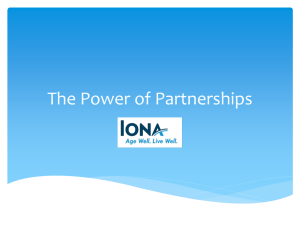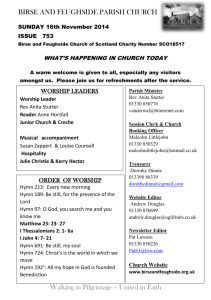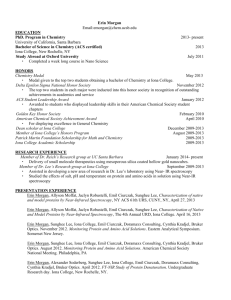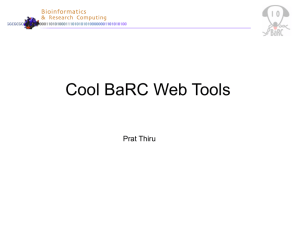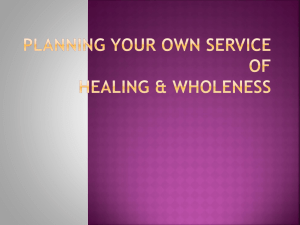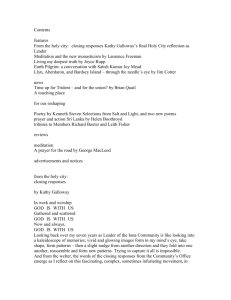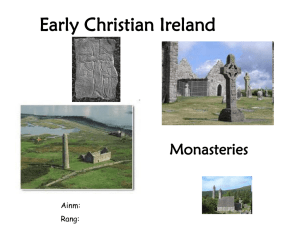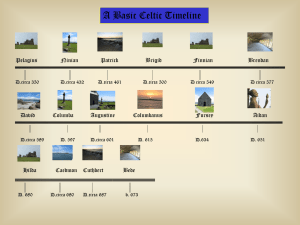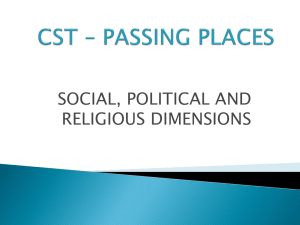Homecoming
advertisement
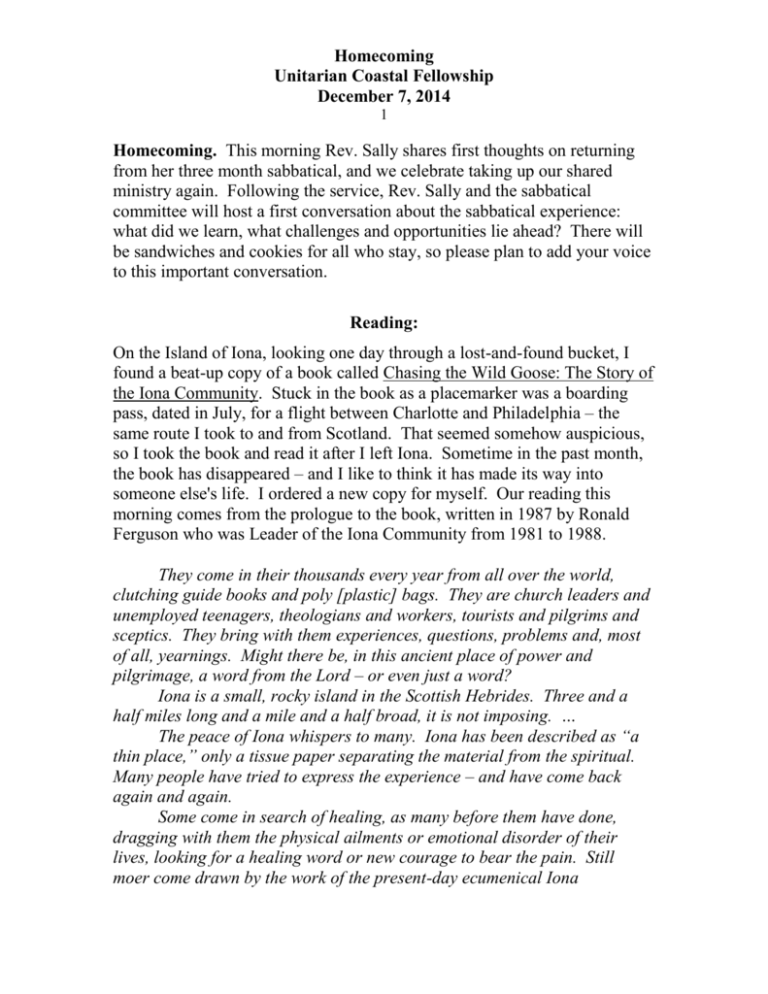
Homecoming Unitarian Coastal Fellowship December 7, 2014 1 Homecoming. This morning Rev. Sally shares first thoughts on returning from her three month sabbatical, and we celebrate taking up our shared ministry again. Following the service, Rev. Sally and the sabbatical committee will host a first conversation about the sabbatical experience: what did we learn, what challenges and opportunities lie ahead? There will be sandwiches and cookies for all who stay, so please plan to add your voice to this important conversation. Reading: On the Island of Iona, looking one day through a lost-and-found bucket, I found a beat-up copy of a book called Chasing the Wild Goose: The Story of the Iona Community. Stuck in the book as a placemarker was a boarding pass, dated in July, for a flight between Charlotte and Philadelphia – the same route I took to and from Scotland. That seemed somehow auspicious, so I took the book and read it after I left Iona. Sometime in the past month, the book has disappeared – and I like to think it has made its way into someone else's life. I ordered a new copy for myself. Our reading this morning comes from the prologue to the book, written in 1987 by Ronald Ferguson who was Leader of the Iona Community from 1981 to 1988. They come in their thousands every year from all over the world, clutching guide books and poly [plastic] bags. They are church leaders and unemployed teenagers, theologians and workers, tourists and pilgrims and sceptics. They bring with them experiences, questions, problems and, most of all, yearnings. Might there be, in this ancient place of power and pilgrimage, a word from the Lord – or even just a word? Iona is a small, rocky island in the Scottish Hebrides. Three and a half miles long and a mile and a half broad, it is not imposing. … The peace of Iona whispers to many. Iona has been described as “a thin place,” only a tissue paper separating the material from the spiritual. Many people have tried to express the experience – and have come back again and again. Some come in search of healing, as many before them have done, dragging with them the physical ailments or emotional disorder of their lives, looking for a healing word or new courage to bear the pain. Still moer come drawn by the work of the present-day ecumenical Iona 2 Community which, having rebuilt the living quarters of the Abbey, seeks to live the Gospel of justice and reconciliation in today's troubled world. Yes, and many are tourists, clutching souvenirs, unsure whether to scoff or to pray. Among them are the post-Christian children of a fragmented and disquieted era. They are rightly suspicious of Celic romanticism, medieval nostalgia, authoritarian clerics and trendy priests. They know there are things not right with the world they live in, not right with their own lives, but they are pretty sure that the old faith is as redundant as they often feel themselves to be. Pretty sure...Yet their feet have travelled this well-worn pilgrim way, walking with uneasy detachment. The feelings become even more mixed as the words spoken at the ancient shrine of piety turn out to be not just historical words, but contemporary syllables. [Chasing the Wild Goose, pp. 15-16]. Sermon: To get to Iona, my cousin Jane and her partner Rob drove me across Scotland from their home in Perth to the ferry port town of Oban. We passed fields with grazing sheep and cows. The road snaked alongside rivers and skirted hills where the bracken was going yellow. We stopped at The Famous Grouse Distillery for morning tea (and “passed” on the distillery tour and the whiskey-tasting). We stopped for lunch at the base of Ben (mount) Cruachan, at the side of Loch Awe. It was two days after the vote on Scottish Independence, and signs and flags saying “Yes!” and “No, thanks” were still visible in house windows and pastures and plastered to poles in the towns. In Oban, we had time to stretch our legs and walk along the pretty waterfront before I checked in at the ferry terminal, and Jane and Rob left to drive back across the country to get home before dark. Standing with my suitcase, waiting for the ferry, an Australian woman struck up a conversation: “Are you going to Iona?” she asked. “I am.” I replied – “You, too?” She was. Elaine and I talked as we waited, and together we boarded the big Caledonian-MacBrayne boat (big enough to accommodate cars and tour buses and hundreds of foot passengers). We talked through the 45-minute ferry ride to Craignure on the east coast of the Island of Mull, and through hour-and-a-quarter-long bus trip across Mull to Fionnphort on the west coast, and then through the short, cold ferry ride across the Sound of Iona to Iona itself. By the time we arrived, it was nearly dark. Peter met us at the pier, helped to load our luggage into the Abbey van, and then led us as we walked in the dusk up the village street, turned at the ruins of the old nunnery, and made our way along the road. And then we saw it. Silhouetted against the sky and the water of the Sound, there was the Abbey church and the community buildings that surrounded the cloister and the tall Celtic crosses, one right near the door and one standing a little away. Stone buildings originally built between 1200 and 1400, standing still and calm and somehow welcoming and almost familiar, even at first sight. Our ferry had run late and everyone else had finished dinner, but we were seated at two of the long refectory tables and we passed around bowls of pasta and sauce, salad and bread, spice cake for “pudding” (in other words, dessert) and big pots of tea. Because we were late, we were excused from helping with the clearing and the washing-up – for that night. There was just time to take our suitcases to our rooms, and then join the others at the introductory program session across the road in the MacLeod Center. The program for the week was called “The Pilgrimage of Life.” In the midst of a hundred strangers who had all traveled long and far to get here, together we named the elements that help to create and sustain community, even – especially – a transient community like this one, that comes together for a week of working and learning and then disperses. Spiritual sustenance, interdependence, humility, trust; food, laughter, wisdom, order and discipline, a variety of gifts and the eyes (or the heart) to see them, curiosity and a willingness to be open, and to be vulnerable. The program leader, Alastair McIntosh, a Scottish writer, activist, human ecologist, and pilgrim (I would characterize him as a “wide thinker”) drew on Joseph Campbell when he named the three stages or movements of a pilgrimage: the departure, a time of going out, away from what is known and familiar; the initiation, a time of encountering challenges and being transformed; the return, back to the place you cam from, bringing new wisdom, new energy, new courage, new questions to the building of a new, transformed community. Leaving community and then returning; building community, sustaining community, being community: this is the beating heart of the Iona Community, and of the experiences they offer to tourists and pilgrims and sceptics. I was drawn to Iona not by the lure of community but rather by the offered program on pilgrimage, for I saw my sabbatical trip as a pilgrimage of sorts, searching for my roots in the country of my mother's birth, where two of my first cousins and four of their children and two grandchildren live. And, as is the way of pilgrimages, I was surprised, and what I found was not what I expected. I went searching for roots, and instead I found wings. For the symbol of the Iona Community is the wild goose, said to be the Celtic symbol for the Holy Spirit (you'll see it on the cover of your Order of Service). And I found myself deeply moved by that wild spirit, in ways that I – like many others, according to Ronald Ferguson – struggle to express. 6 But let me begin by telling you another story, one I heard on the second night on Iona. It is a story in three chapters. In the year 563, a 42-year-old Irish priest and twelve followers – all men, mainly relatives – journeyed north from Ireland in small, open, leatherbound boats called coracles. In the late spring, on the eve of Pentecost, they landed on a rocky beach on the small island of Iona. Legend has it that they climbed the hill to the west of the beach and looked southward toward Ireland – and when they were sure they could no longer see their homeland, they set about building a monastery - wooden church, farm buildings, workshops andsmall houses – on the island. Work and worship were inseparable, and part of the work they undertook was missionary work. Remote as Iona is today, it sits at a crossroads of navigation by water, and St. Columba and his followers carried their Christian message north to the Picts in Scotland, South to the Anglo-Saxons in England, and as far east as western Russia [The Iona Abbey Worship Book p. 167]. The Celtic Christian community on Iona thrived for more than 200 years until the early 800s, when Viking raids forced the monks to abandon the island and relocate to Kells, in Ireland. It is believed that they took with them the illuminated manuscript now known as the Book of Kells. Thus ends chapter one. In the 1200s, Benedictine monks established a new community on Iona, more focused on worship and orderly community than on mission and outreach. They built a church and community buildings of stone; not far away, an Augustinian nunnery was also built of stone. These religious communities were dispersed after 1560, when the reformation came to Scotland and Catholicism was replaced by the Protestant Church of 7 Scotland. The stone buildings fell into disrepair. And thus ends chapter two. Fast forward to 1930. George MacLeod was the minister of the parish church in Govan, a section of Glasgow that had long been a shipbuilding center. The church, a Church of Scotland congregation, was old and wellrespected; the congregation included respected citizens and community leaders. But this was the Depression and nobody was building ships – or anything else for that matter. The neighborhood around the church was full of out-of work craftsmen: shipbuilders and carpenters and stonemasons. They did not come to the church – it looked to them as though the church had nothing to offer them, and they did not feel welcome among the welldressed members of George MacLeod's congregation. The wall around the church seemed to them to serve to keep them out. But George MacLeod had a different vision of church, as a place that takes people in rather than closing them out. He and a team of volunteers knocked on doors all over Govan, invited the neighbors to church, and welcomed them in. Soon they undertook a work project: unemployed craftsmen used their skills to rebuild a broken-down old mill on the outskirts of Glasgow, and make it into a holiday retreat for inner-city families. The men were glad to have work, even if it didn't pay; MacLeod was deeply moved by the way in which working together on a demanding common task created a community out of individuals who seemed to have little in common. And so, in 1938, with the mill rebuilt, George MacLeod looked around for another project. This time, he included not only craftsmen but also students studying for the ministry, many of whom had never spent time with men 8 who worked with their hands instead of their intellects. This would be an experiment in training Church of Scotland ministers for ministry not in pastoral farming villages or prestigious city churches but in industrial neighborhoods and manufacturing towns. And part of the training would be to work hand-in-hand with the people they would later serve – craftsmen and laborers. The project: rebuilding the Abbey buildings on Iona. Not restoring them, not putting them back the way they had once been, but building on what was there and making something new and filled with life. The church, the cloister, the chapter house, the refectory and dormitories. A community built on lay people and clergy, young and old. A community that lived the teachings of the church not just on Sunday but every day. Not just in the sanctuary or the meeting room, but in the High Street, and in every aspect of life. The Iona Community, it is called. Today, seventy-six years later, the Iona Community is (and I have paraphrased slightly): an ecumenical movement of men and women from different walks of life and different traditions in the Christian church committed to the embodying [the life and the teachings of Jesus] and to following where that leads, even into the unknown engaged together, and with people of goodwill across the world, in acting, reflecting,and praying for justice, peace, and the integrity of creation convinced that the inclusive community we seek must be embodied in the community we practice [Chasing the Wild Goose, p. 189]. 9 For a week in September, I lived in the embrace of the Iona Community. We each had a job, so we worked together. We met together to learn about plgrimage. We joined the weekly pilgrimage walk to places of historic and religious significance. Twice each day we worshipped togther in the Abbey church. Listening through the trinitarian language, I was astonished to hear a respect and an inclusivity that I had naively thought were unique to Unitarian Universalism. On Iona, I felt 1450 years of history converge on a worshipping community that took shape within the week that I was there – a community that began with Elaine from Australia and grew to include members from England and Scotland and Holland and Sweden and the United States and India and Germany – and that included even me, a non-trinitarian Unitarian Universalist from North Carolina. Sitting in that ancient stone bulding where ferns grow in cracks in the walls, I was deeply moved by an opening litany that calls on us to speak out for justice, for peace, for mercy, saying in effect “if we ourselves keep silent, these stones would shout aloud.” [Iona Abbey Worship Book, The Morning Service, opening responses, p. 15, rephrased.] This morning, I rejoin you, and I bring you the words that I can find. words feel hardly adequate, and the work of sharing with you what I have learned is work that will be ongoing. But stones are more solid than words, and so I have also brought you stones, gathered on a beach on Iona. I have placed them on a plate, at the base of our circle of friends. Please take one, and let it be for you a small piece of my journey, shared. And let it bring 10 into your life whatever you need that is solid, and holy, and infused with the Spirit of Life, and Love. And let us now, in silence, listen for the echoes of all we have heard this morning, spoken and unspoken. The bell will lead us into silence, and music will lead us out. Bell Silence Music Amen.
